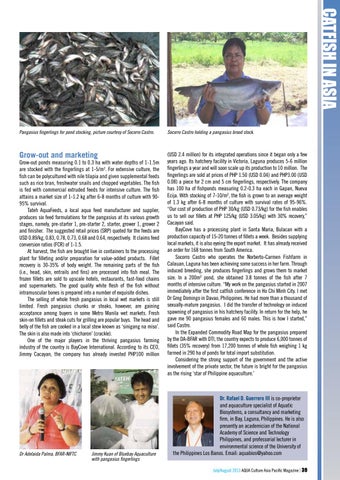catfish IN ASIA
Pangasius fingerlings for pond stocking, picture courtesy of Socorro Castro.
Socorro Castro holding a pangasius brood stock.
Grow-out and marketing
(USD 2.4 million) for its integrated operations since it began only a few years ago. Its hatchery facility in Victoria, Laguna produces 5-6 million fingerlings a year and will soon scale up its production to 10 million. The fingerlings are sold at prices of PHP 1.50 (USD 0.04) and PHP3.00 (USD 0.08) a piece for 2 cm and 5 cm fingerlings, respectively. The company has 100 ha of fishponds measuring 0.2-0.3 ha each in Gapan, Nueva Ecija. With stocking of 7-10/m2, the fish is grown to an average weight of 1.3 kg after 6-8 months of culture with survival rates of 95-96%. “Our cost of production of PHP 30/kg (USD 0.73/kg) for the fish enables us to sell our fillets at PHP 125/kg (USD 3.05/kg) with 30% recovery,” Cacayan said. BayCove has a processing plant in Santa Maria, Bulacan with a production capacity of 15-20 tonnes of fillets a week. Besides supplying local markets, it is also eyeing the export market. It has already received an order for 168 tonnes from South America. Socorro Castro who operates the Norberto-Carmen Fishfarm in Calauan, Laguna has been achieving some success in her farm. Through induced breeding, she produces fingerlings and grows them to market size. In a 200m2 pond, she obtained 3.8 tonnes of the fish after 7 months of intensive culture. “My work on the pangasius started in 2007 immediately after the first catfish conference in Ho Chi Minh City. I met Dr Greg Domingo in Davao, Philippines. He had more than a thousand of sexually-mature pangasius. I did the transfer of technology on induced spawning of pangasius in his hatchery facility. In return for the help, he gave me 90 pangasius females and 60 males. This is how I started,” said Castro. In the Expanded Commodity Road Map for the pangasius prepared by the DA-BFAR with DTI, the country expects to produce 6,000 tonnes of fillets (35% recovery) from 17,200 tonnes of whole fish weighing 1 kg farmed in 290 ha of ponds for total import substitution. Considering the strong support of the government and the active involvement of the private sector, the future is bright for the pangasius as the rising ‘star of Philippine aquaculture.’
Grow-out ponds measuring 0.1 to 0.3 ha with water depths of 1-1.5m are stocked with the fingerlings at 1-5/m2. For extensive culture, the fish can be polycultured with nile tilapia and given supplemental feeds such as rice bran, freshwater snails and chopped vegetables. The fish is fed with commercial extruded feeds for intensive culture. The fish attains a market size of 1-1.2 kg after 6-8 months of culture with 9095% survival. Tateh AquaFeeds, a local aqua feed manufacturer and supplier, produces six feed formulations for the pangasius at its various growth stages, namely, pre-starter 1, pre-starter 2, starter, grower 1, grower 2 and finisher. The suggested retail prices (SRP) quoted for the feeds are USD 0.89/kg, 0.83, 0.78, 0.73, 0.68 and 0.64, respectively. It claims feed conversion ratios (FCR) of 1-1.5. At harvest, the fish are brought live in containers to the processing plant for filleting and/or preparation for value-added products. Fillet recovery is 30-35% of body weight. The remaining parts of the fish (i.e., head, skin, entrails and fins) are processed into fish meal. The frozen fillets are sold to upscale hotels, restaurants, fast-food chains and supermarkets. The good quality white flesh of the fish without intramuscular bones is prepared into a number of exquisite dishes. The selling of whole fresh pangasius in local wet markets is still limited. Fresh pangasius chunks or steaks, however, are gaining acceptance among buyers in some Metro Manila wet markets. Fresh skin-on fillets and steak cuts for grilling are popular buys. The head and belly of the fish are cooked in a local stew known as ‘sinigang na miso’. The skin is also made into ‘chicharon’ (crackle). One of the major players in the thriving pangasius farming industry of the country is BayCove International. According to its CEO, Jimmy Cacayan, the company has already invested PHP100 million
Dr Adelaida Palma, BFAR-NIFTC
Jimmy Kuan of Bluebay Aquaculture with pangasius fingerlings
Dr. Rafael D. Guerrero III is co-proprietor and aquaculture specialist of Aquatic Biosystems, a consultancy and marketing firm, in Bay, Laguna, Philippines. He is also presently an academician of the National Academy of Science and Technology Philippines, and professorial lecturer in environmental science of the University of the Philippines Los Banos. Email: aquabios@yahoo.com July/August 2013 AQUA Culture Asia Pacific Magazine | 39
